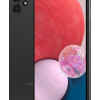Review: Kyocera Zio
I've come to expect a certain level of quality from Kyocera and Sanyo. To be honest, that bar isn't set very high. Thankfully, the Zio surmounts it, and is (mostly) a well-made handset. The fit and finish isn't as tight and refined as some of the recent Android handsets from Samsung or Motorola, but it feels great in the hand. All the edges are rounded and smooth, and the battery cover has a soft-touch finish that gives it just the right amount of grip. It might be a little bit thicker than most slate-style Android devices, but given the overall small footprint, that's a forgivable offense.
The front of the Zio is mostly the display, below which are the typical Android controls in the form of capacitive touch icons. The icons are completely flush with the surface of the Zio, and there's nothing to let you know that they are there aside from the lighted graphic. It takes practice to feel them out, but they were responsive enough that I didn't miss physical buttons. Physical Send and End keys are positioned directly below the capacitive controls, and both are easy to find and have good travel and feedback.
Sanyo opted to go with a trackball for navigation and fine-tuned cursor control on the Zio's screen. The Zio's trackball is easily the worst I have ever encountered. First, the ball was somewhat loose in the socket. Second, it was difficult to get the ball to move at all, in any direction. Third, when it did move, the cursor followed the ball's movements perhaps 10% of the time. It's so bad that I would suggest skipping the trackball altogether. It is possible that the trackball on our review unit is defective.
There are two hatches and a button on the left side of the Zio. The top-most hatch covers the 3.5mm headset jack. I'd call this superfluous. I understand the idea behind protecting the headset jack from dust, lint, and dirt, but I don't like to have a hatch bumping up against my headphone cord. Despite that complaint, the hatch itself works fine. The volume toggle is below the headset hatch. It has the same soft-touch finish that the back side of the Zio has, and this makes it easy to find against the smooth, glossy surface of the Zio's side. It has good travel and feedback. The hatch near the bottom of the Zio covers the microUSB port. This hatch also works well.
The right side of the Zio has a hatch covering the microSD card port and a dedicated camera button. I prefer to have access to the microSD card on the outside of the phone and not under the battery cover, so I appreciate the positioning on the Zio. The camera key is a two-stage button. It's a delicate key. The definition between the two stages is so slight that it's easy to miss. This button will take most users some practice to master.
Overall, the Zio is a decent handset. Were it not for the trackball, I'd even call it good. But the lower-than-average build quality might put some potential buyers off.











 Video Tour: Sanyo Zio for Sprint
Video Tour: Sanyo Zio for Sprint
 CTIA Fall 2010
CTIA Fall 2010
 AT&T's Newest 5G Phone Offers Wireless Charging for $220
AT&T's Newest 5G Phone Offers Wireless Charging for $220
 Cheaper Samsung Galaxy A13 Launches on AT&T Without 5G
Cheaper Samsung Galaxy A13 Launches on AT&T Without 5G
 Cricket Doubles Down on White-Label Phones
Cricket Doubles Down on White-Label Phones
 Sanyo Zio by Kyocera
Sanyo Zio by Kyocera



